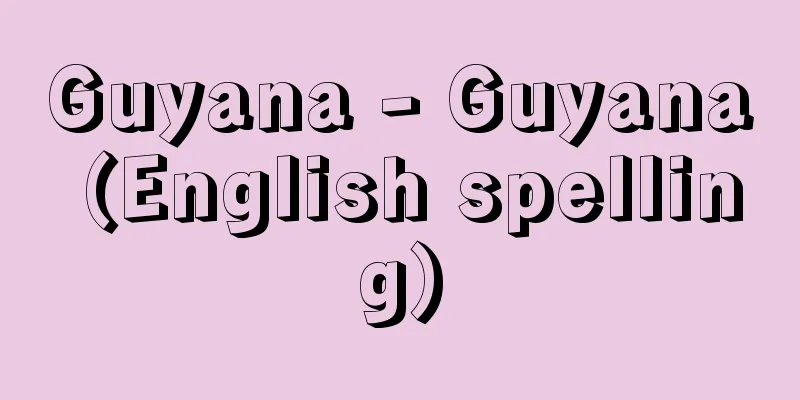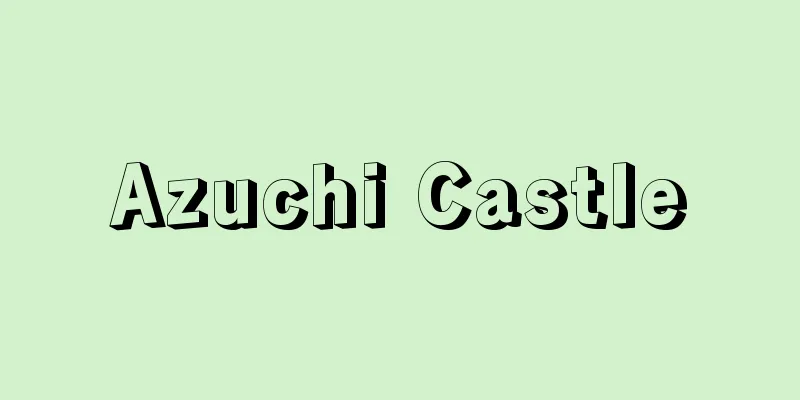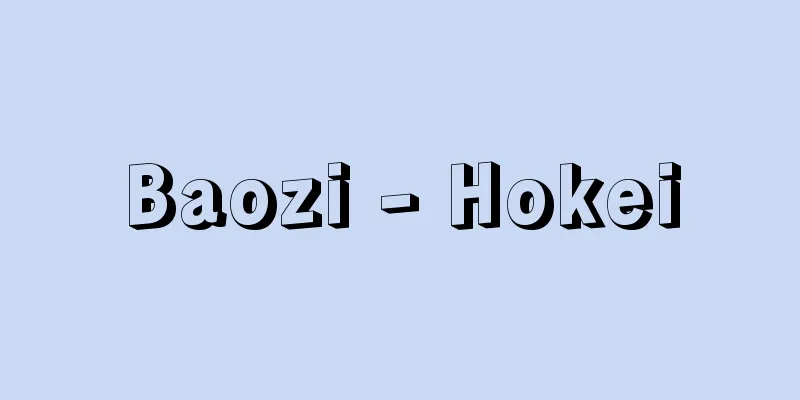Guyana - Guyana (English spelling)

|
A country in northern South America. Its official name is The Co-operative Republic of Guyana, and it has aimed to develop a unique form of socialism based on a cooperative system. It borders Venezuela to the west, Brazil to the south, Suriname to the east, and faces the Atlantic Ocean to the northeast. It was formerly known as British Guiana. It has an area of 215,000 square kilometers and a population of 760,000 (estimated as of 2000). The population density is 3.5 people per square kilometer. The capital is Georgetown. The country's name means "water town" (land with water) in the indigenous language. [Shozo Yamamoto] Nature70% of the country is made up of peneplains with an elevation of less than 200 meters and narrow coastal plains. The Pacaraima Mountains run along the western border, and the Acaray Mountains run along the southern border, but most of the mountainous area is made up of hills with an elevation of less than 500 meters. The basin of the main tributary of the Essequibo River, which runs through the center from south to north, occupies most of the country. The Barima River flows in the northwest, the Berbice River in the east, and the Corantyne River divides the country at the border with Suriname. The coast is mostly marshy land below sea level. 85% of the country is covered by forests, and inland there are parts of savannah. Annual precipitation reaches 2,500 mm in the coastal regions, with two rainy seasons, from May to August and from November to January. On the other hand, inland in the southwest, it is less than 1,500 mm, and there is only one rainy season per year (April to September). Temperatures are high all year round, with the average annual temperature in the capital, Georgetown, being 26.7°C. [Shozo Yamamoto] History and politicsThe Spanish arrived in 1499, but were driven out (1596) when the Dutch established a colony (1581). The British then acquired the area, and the colony of British Guiana was established in 1831. Initially, the Dutch brought in black African slaves, but between 1838 and 1917, the British brought in Indians and Chinese as laborers for sugarcane cultivation, which led to the complex racial makeup we see today. The Executive Yuan was established in 1891, and the Legislative Yuan in 1928, and the internal affairs of the country were gradually developed. After the Second World War, an autonomous government was elected in 1953, taking the first step towards independence, and in May 1966, the country gained independence within the British Commonwealth. In 1968, the People's National Congress (PNC) won the first general election after independence, organized a single government, and in February 1970, amended the constitution to establish a republic. The new government aimed to achieve a nationally independent economy and pursued socialist policies, and the name of the country was changed to "cooperative republic." After 1985, the country shifted from a socialist-oriented approach to a more centrist one, and sought to approach developed countries. The government, led by the People's Progressive Party, maintained a market economy, and President Cheddi Jagan, of Indian descent, who took office in 1992, actively appointed African-American personnel and implemented racial reconciliation policies, but he died in March 1997, and in the presidential election held at the end of the same year, his wife Janet Jagan was elected. Janet Jagan then resigned for health reasons in August 1999, and Bharat Jagdeo became president. [Shozo Yamamoto] Economy and IndustryGuyana's economy is mainly supported by agriculture and mining. Although the agricultural population is only 65,000 (20.6% in 1994), agriculture remains an important industry. The main products are sugarcane and rice. A 5-10 km wide lowland along the coast has been reclaimed by embankments and large plantations have been established. Sugarcane and processed sugarcane products account for 44.1% of total exports, most of which are exported to Commonwealth countries. Meanwhile, rice production is 340,000 tons (1994). Rice is mainly grown by small Indian farmers, but productivity is low and the average cultivated land area per household is less than 2 hectares. Other agricultural products produced include coconuts, oranges, and bananas. Mineral resources include bauxite, and small amounts of gold, diamonds, copper, manganese, etc. Bauxite production reached 3.05 million tons in 1980, but dropped sharply to 2.2 million tons in 1985 and 1.42 million tons in 1990, before recovering to 2.093 million tons in 1994. There is also a lot of room for development of timber resources. The top export items are sugar, gold, bauxite, and rice, in that order, with total export value of $391 million. Imports include fuel and other items, with a total import value of $406 million (1995), resulting in a trade deficit of $15 million. The top import sources are the United States and Trinidad and Tobago, in that order. Although it is not well versed in Latin American countries, it has formed the Caribbean Community and Caribbean Common Market with Jamaica, Barbados, and Trinidad and Tobago (launched in August 1973). It is also working to strengthen its cooperative relationship with Cuba. The Atlantic continental shelf is a good fishing ground for shrimp, and trade with Japan is centered around this area. [Shozo Yamamoto] society90% of the population is concentrated in a small coastal area (less than 5% of the country's land area) centered on the capital, Georgetown. The main cities are New Amsterdam, a former Dutch town and the center of a rich agricultural region, and Lindem, a bauxite mining town. The gross national income (GNI) per capita is low at $770 (2000), and the illiteracy rate is said to be around 12%. The racial composition is East Indian (Indian-Pakistani) 49%, African 36%, mixed race 7%, and indigenous Indian 7%. Race is closely linked to occupation and area of residence, and racial conflict between Indians and blacks is serious. East Indians mainly work on sugarcane plantations and in the rainy coastal areas, while African residents are mostly urban residents. Indigenous people are scattered in the forest areas of the interior and engage in hunting and primitive agriculture. Christianity (Church of England) is the most common religion, accounting for 57% of the total population, followed by Hinduism at 34% and Islam at 9%. English is the official language, but Hindu, Chinese, and African languages are also spoken by each race. It is truly a multi-racial and multi-religious society, and a major challenge for the country is to achieve social unity and culture that transcends such a complex racial makeup, and it is trying to achieve this through English culture. [Shozo Yamamoto] [Supplementary Material] |"> Guyana flag ©Shogakukan Illustration/Shogakukan Creative "> Guyana location map Source: Shogakukan Encyclopedia Nipponica About Encyclopedia Nipponica Information | Legend |
|
南アメリカ北部の国。正称はガイアナ協同共和国The Co-operative Republic of Guyanaで、共同組合制度を基礎とする特異な社会主義を目ざしてきた。西はベネズエラ、南はブラジル、東はスリナムに接し、北東は大西洋に面する。旧称イギリス領ギアナ。面積21万5000平方キロメートル、人口76万(2000推計)。人口密度は1平方キロメートル当り3.5人。首都はジョージタウン。国名は先住民の言語で「水郷(水のある土地)」という意味である。 [山本正三] 自然国土の70%は標高200メートル以下の準平原と狭い海岸平野からなる。西の国境に沿ってパカライマ山脈、南の国境にはアカライ山脈が走るが、山地の大部分は500メートル以下の丘陵で形成される。中央部を南から北に貫流するエセキボ川の本支流の流域が国土の大部分を占める。北西部にはバリマ川、東部にはバービス川が流れ、スリナムとの国境をコーランタイン川が分けている。海岸は海面より低い湿地が多い。国土の85%は森林に覆われ、内陸には部分的にサバンナ地帯がみられる。年降水量は、海岸地方では2500ミリメートルに達し、雨期は5~8月と11月~1月の2回である。一方、南西部の内陸では1500ミリメートル前後と少なく、雨期も年1回(4~9月)である。気温は一年中高温で、首都ジョージタウンの年平均気温は26.7℃である。 [山本正三] 歴史・政治1499年にスペイン人が来航したが、オランダの植民地建設(1581)により、スペインはこの地を追われた(1596)。その後イギリスの買収によって、1831年イギリス領ギアナ植民地が誕生した。当初オランダはアフリカ黒人奴隷を導入したが、1838年から1917年にかけてイギリスがサトウキビ栽培のためにインド人や中国人を労働者として導入したため、これが現在の複雑な人種構成のもととなった。1891年行政院、1928年立法院が設けられ、徐々に内政の整備が進められた。 第二次世界大戦後、1953年に自治政府が選出され、独立への第一歩を踏み出し、66年5月イギリス連邦内の独立を獲得した。68年人民民族会議(PNC)は、独立後初の総選挙に勝ち、単独政権を組織し、70年2月憲法を改正して共和国を樹立した。新政権は民族的自立経済の達成を目標に社会主義政策を志向し、国名に「協同共和国」が付加された。85年以後、社会主義重視路線から中道に転換し、先進諸国への接近を図った。人民進歩党を主体とする政権は市場経済を守り、92年就任したインド系大統領チェディ・ジェーガンはアフリカ系人材を積極的に起用し、人種間の融和策を実施したが、97年3月に死去、同年末に行われた大統領選挙ではチェディ・ジェーガンの夫人であるジャネット・ジェーガンが当選した。その後、99年8月にジャネット・ジェーガンは健康上の理由で辞任、バラット・ジャグデオが大統領に就任した。 [山本正三] 経済・産業ガイアナの経済は主として農業、鉱業で支えられる。農業人口は6万5000人(20.6%、1994)を占めるにすぎないが、農業は依然として重要な産業である。主要産物はサトウキビと米である。海岸沿いの5~10キロメートル幅の低地は築堤により干拓され、大規模なプランテーションが行われている。サトウキビおよびその加工品は輸出総額の44.1%を占め、ほとんどはイギリス連邦諸国に輸出される。一方、米の生産量は34万トン(1994)である。米は主としてインド人小農民によって栽培されるが、生産性は低く、1戸当りの平均経営耕地面積も2ヘクタールに満たない。農産物ではそのほかココナッツ、オレンジ、バナナなども生産される。 鉱産資源は、ボーキサイトがあり、その他少量ながら、金、ダイヤモンド、銅、マンガンなどを産する。ボーキサイトの産出量は1980年305万トンに達したが、85年220万トン、90年142万トンと激減し、94年に209万3000トンにまで回復した。そのほか木材資源も開発の余地が大きい。 輸出品は、砂糖、金、ボーキサイト、米の順で比率が高く、輸出総額は3億9100万ドル。輸入品は燃料などで輸入総額は4億0600万ドル(1995)で、1500万ドルの入超である。輸入先は、アメリカ、トリニダード・トバゴの順で多い。ラテンアメリカ諸国とは疎遠だが、ジャマイカ、バルバドス、トリニダード・トバゴとともにカリブ共同体、カリブ共同市場を結成している(1973年8月発足)。またキューバとの協力関係の強化を図っている。 大西洋岸大陸棚はエビの好漁場で、これを中心に日本との交易が進んでいる。 [山本正三] 社会人口の90%は首都ジョージタウンを中心とする海岸の狭い地帯(国土の5%足らず)に集中する。旧オランダ人の町で豊かな農業地帯の中心ニュー・アムステルダム、ボーキサイト鉱山の都市リンデムがおもな都市である。 1人当りの国民総所得(GNI)は770ドル(2000)と低く、また非識字率も12%程度といわれている。人種構成は、東インド人(インド・パキスタン系)49%、アフリカ系36%、混血7%、先住民のインディオ7%などからなっている。人種は、職業および居住地域と密接な結び付きをもち、インド系と黒人系との人種対立が深刻である。東インド人はおもにサトウキビ・プランテーションと海岸の多雨地帯で働いており、アフリカ系住民は都市居住者が多い。先住民は内陸部の森林地帯に散在し、狩猟や原始的農業に従事している。宗教は、キリスト教(イングランド教会)信仰者がもっとも多く、全人口の57%を占め、ついでヒンドゥー教34%、イスラム教9%と続く。言語は、英語が公用語であるが、ヒンドゥー語、中国語、アフリカ系の言語も各人種によって用いられている。まさしく多人種、多宗教社会であり、このような複雑な人種構成を越えた社会的統一と文化の形成が、この国の大きな課題で、英語文化によりそれを成し遂げようとしている。 [山本正三] [補完資料] |"> ガイアナの国旗 ©Shogakukan 作図/小学館クリエイティブ"> ガイアナ位置図 出典 小学館 日本大百科全書(ニッポニカ)日本大百科全書(ニッポニカ)について 情報 | 凡例 |
>>: Gaia - Gaia (English spelling)
Recommend
Beanland Legend - Beanland Legend
According to the Icelandic sagas, Greenlandic colo...
Electrohydrodynamic generator
… Methods being researched for this purpose inclu...
Savoldo, Giovanni Girolamo
Born: Around 1480 in Brescia [Died] After 1548. Ve...
Resonance (English spelling)
[1] The phenomenon in which a vibrating body begi...
Oxide minerals
A mineral that is composed of oxygen and other el...
Pomponazzi - Pomponazzi (English spelling) Pietro Pomponazzi
Italian Renaissance philosopher. Born in Mantua. ...
Hoa Binh Culture
A culture believed to date to the early Holocene ...
Magistratus
...It is not clear when and how the distinction b...
Channel catfish
…It resembles the Japanese catfish, but can be di...
Sentence completion test
It is abbreviated as SCT. Incomplete sentences are...
Matsumoto Jiichiro - Matsumoto Jiichiro
Social activist and politician. Born in Kanehira ...
Post office - station
〘Noun〙 Post office. In the Japanese system, it was...
Akakura [Hot Springs] - Akakura
It is located in Myoko-Kogen Town (now Myoko City)...
Atelopus
...However, the family also includes the non-pois...
《Grand dictionnaire universel du IXIX siècle》 (English notation) GranddictionnaireuniverselduIXIXsiecle
… [Matsubara Shuichi]. … *Some of the terminology...









